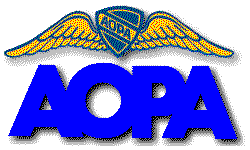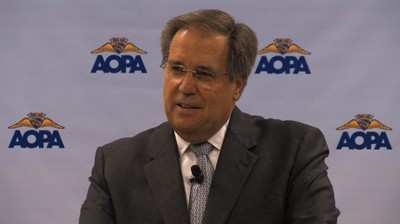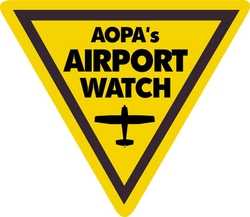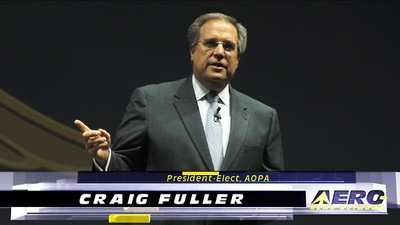Prepares For 'A Year Of Challenges, Opportunities'
 Craig L. Fuller has taken the
controls as president of the Aircraft Owners and Pilots Association
- only the fourth president in the Association's nearly 70-year
history. Fuller became president on January 1, 2009, following an
orderly three-month transition leading up to outgoing president
Phil Boyer's retirement on December 31, 2008.
Craig L. Fuller has taken the
controls as president of the Aircraft Owners and Pilots Association
- only the fourth president in the Association's nearly 70-year
history. Fuller became president on January 1, 2009, following an
orderly three-month transition leading up to outgoing president
Phil Boyer's retirement on December 31, 2008.
"I see a year of challenges, but I also see a year of
opportunities," Fuller said in a New Year's video greeting to
members. "Much work has already begun with the new Obama
administration. We've met with the transition team, and those
officials have been concerned about the issues that concern all of
us."
AOPA and its members recognize that the overriding concern for
the new administration - and the nation in general - is the
economy.
Expressing AOPA's commitment to play a leadership role in a
letter to President-elect Barack Obama, Fuller wrote, "Aviation is
an integral part of this country's infrastructure and economy and I
can assure you that AOPA is ready to work with you on the pressing
issues facing the aviation industry. Top among these challenges are
aviation safety, modernizing the nation's air traffic control
system, long term financing of aviation infrastructure, aviation
security, and responding to environmental issues."
One of the keys to addressing all of these issues is finding the
right person to head the Federal Aviation Administration.

FAA Administrator
 The FAA needs a strong leader to
direct the agency, respond to the challenges facing the aviation
industry, improve air safety, and ensure that the air
transportation system continues its role in the economic
revitalization of the country.
The FAA needs a strong leader to
direct the agency, respond to the challenges facing the aviation
industry, improve air safety, and ensure that the air
transportation system continues its role in the economic
revitalization of the country.
AOPA believes President Obama needs to choose an FAA
Administrator who has technical and people-management skills -
including labor relations - combined with an understanding of the
aviation industry and the political acumen necessary to lead the
organization.
FAA Reauthorization
Enacting long-term financing that makes federal investments in
safety, modernizing the air traffic control system, FAA operations,
airport improvements and government aviation research efforts is
crucial to ensuring the future of aviation in the United States.
AOPA strongly supported the approach contained in H.R. 2881 during
the 110th Congress, which used the time-tested system of passenger
ticket and general aviation fuel excise taxes instead of user
fees.
AOPA has urged the new Obama administration to follow a similar
course. This is a top issue for AOPA members, who have made it
clear they remain adamantly opposed to user fees for any segment of
the aviation industry.
Air Traffic Control Modernization
For nearly two decades, the FAA has been has been in the process
of migrating from a ground-based air traffic control system to a
satellite-based system that relies on the Global Positioning System
(GPS) for navigation, aircraft position and precision timing.
However, this modernization effort (often referred to as the Next
Generation Air Transportation System - or NextGen) must be better
defined to include the plan for specific ground and aircraft
equipment, costs to the government and to aircraft operators,
schedules and the benefits of NextGen which have yet to be clearly
articulated.
The absence of this type of planning has generated important
unresolved issues with the FAA's rulemaking and initial contract
for implementing the Automatic Dependant Surveillance-Broadcast
(ADS-B) system that ultimately replaces ground based radar with GPS
signals as the primary means of air traffic surveillance.
Investment and Protections for Airports
The United States' network of airports is an essential component
of the nation's air transportation system that is vital to the
economic viability of communities across the country. There are
hundreds of "shovel-ready" airport projects in communities across
the country that could create well-paying local jobs. AOPA called
on the incoming administration to support critical aviation
infrastructure with a robust federal airport grant program.

While most political attention is paid to airline airports, the
threats to general aviation airports continue to grow as local
governments consider restrictions on operations, evaluate
potentially incompatible development of the land adjacent to
airports, or attempt to sell and redevelop the airport property
itself. The Obama administration must be proactive in protecting
critical components of our nation's infrastructure through policies
and enforcement of federal airport grant provisions.
General Aviation Security
Recently, general aviation has received a great deal of
attention from the Department of Homeland Security. The new
administration should view general aviation not a threat to U.S.
security, but as an integral part of the transportation system. Any
initiatives, AOPA said, should be based on threat data from
intelligence sources and anything that is implemented to address
reducing vulnerabilities should be as transparent as possible to
the pilot community.
No group has been more committed to enhancing general aviation
security than AOPA. The Association developed the Airport Watch
program, which is now an integral part of the Transportation
Security Administration's guidelines for general aviation airport
security. AOPA has worked with security agencies on a number of
proposals to find commonsense solutions that enhance security while
imposing the least burden possible on pilots.

Environmental Concerns
 While data garnered from the
Intergovernmental Panel on Climate Change suggests that aviation's
greenhouse gas emissions on a global scale are imperceptible
through 2050, there is a need for leadership from the Department of
Transportation and the FAA as interest in the environment affects
aviation.
While data garnered from the
Intergovernmental Panel on Climate Change suggests that aviation's
greenhouse gas emissions on a global scale are imperceptible
through 2050, there is a need for leadership from the Department of
Transportation and the FAA as interest in the environment affects
aviation.
It is crucial that the Obama Administration is prepared to
address proposed policies, regulations and standards that target
aviation gasoline, greenhouse gas emissions, and aircraft
noise.
The Need For More Pilots
Beyond the realm of rules and regulations, one of the greatest
challenges facing the entire aviation industry is the declining
pilot population.
AOPA is determined to reverse the nearly three-decade-long slide
in the number of pilots, and has committed millions of dollars to
do so, with or without government or industry support.
Let's Go Flying! is the centerpiece of AOPA's efforts. The
program seeks to entice anyone who has ever had any interest in
learning to fly with vibrant descriptions of places to go and
things to do once a person has earned a pilot certificate. The
Let's Go Flying! web site provides information on getting started,
including a free DVD, then provides support throughout flight
training, as well as information to help new pilots decide what to
do once they have their license.
"We have our work cut out for us," Fuller said. "But we
believe we start with an important base of support. More than 60%
of voters told us in an Election Night survey that they understand
that general aviation is a vital part of the country's air
transportation system.

"Most importantly," he concluded, "I see a year spent getting
out among the members, talking to them at airports in towns around
the country."
 ANN E-I-C Note: Just got a
very nice note from newly minted AOPA Boss, Craig Fuller, who
seems to be raring to take on the challnges that we
face. As tough as it may be to follow a solid leader like Phil
Boyer, ANN has the feeling that Fuller has "The Wright Stuff" for a
job that will require more poltical savvy than ever before. As soon
as Craig gets used to his new digs, ANN will head out to visit with
him and get a feel for what the future holds for AOPA, and the
future of GA. We wish Craig every success on his acceptance of the
great responsibilities he undertakes and we look forward to working
with him. -- Jim Campbell, ANN E-I-C.
ANN E-I-C Note: Just got a
very nice note from newly minted AOPA Boss, Craig Fuller, who
seems to be raring to take on the challnges that we
face. As tough as it may be to follow a solid leader like Phil
Boyer, ANN has the feeling that Fuller has "The Wright Stuff" for a
job that will require more poltical savvy than ever before. As soon
as Craig gets used to his new digs, ANN will head out to visit with
him and get a feel for what the future holds for AOPA, and the
future of GA. We wish Craig every success on his acceptance of the
great responsibilities he undertakes and we look forward to working
with him. -- Jim Campbell, ANN E-I-C.
 ANN's Daily Aero-Linx (04.13.24)
ANN's Daily Aero-Linx (04.13.24) ANN's Daily Aero-Term (04.13.24): Beyond Visual Line Of Sight (BVLOS)
ANN's Daily Aero-Term (04.13.24): Beyond Visual Line Of Sight (BVLOS) Airborne 04.09.24: SnF24!, Piper-DeltaHawk!, Fisher Update, Junkers
Airborne 04.09.24: SnF24!, Piper-DeltaHawk!, Fisher Update, Junkers Aero-News: Quote of the Day (04.14.24)
Aero-News: Quote of the Day (04.14.24) ANN's Daily Aero-Term (04.14.24): Maximum Authorized Altitude
ANN's Daily Aero-Term (04.14.24): Maximum Authorized Altitude










